Overview
|
The storms produced lots of large hail and some wind damage. Most of the severe weather happened along and south of Route 22 between 3 PM and 8 PM. The storms fried up along a pre-frontal surface trough that had developed ahead of a cold front which was moving southward through PA during the afternoon and evening. Many of the storms exhibited low-level rotation, and had strong storm-top divergance - indicating strong updrafts and mesocyclones. Storm tops on this day over PA reached up to 50 kft at times, with most up to 40 kft. Steep mid-level lapse rates (the rate of cooling as you move up in elevation) and a freezing level around 11 kft provided a good set up for large hail. The worst storm of the bunch was a rotating supercell over Cumberland County. The storm moved through Carlisle about 5 PM, producing very large hail and some wind damge. The low-level rotation was so strong that a tornado warning was issued for central Cumberland County. See the reflectivity and storm-relative motion images from the KCCX 88D below. Inferring the storm structure from the reflectivity panels below, there is a (bounded) weak-echo region (BWER) over and just to the south of Bloserville. This is coincident with the best low to mid-level rotation on the SRM pics. These signatures pair up to indicate a strong, rotating updraft holding lots of water aloft. The area in the storm where the large hail is falling is most likely between Bloserville and Carlisle at 2053 UTC (453 PM EDT). There is a weak hook echo on the SW edge of the storm, which is most likely the base of the mesocyclone (the rotating updraft). A very noticable three-body scatter spike (hail flare) is visible extending SE out of the storm (away from the radar). This signature is another strong indication of a storm with lots of hail being held aloft. There is so much power reflected back to the radar in those radials that the radar has trouble specifying a distance and azimuth of the strong returns due to the hail stones themselves bouncing the radar energy around inside the storm core before returning it to the radar site. Hail of up to 2 inches was reported from this storm as it continued to move SE through northern York County and the western edge of Lancaster County. |
|
Radar
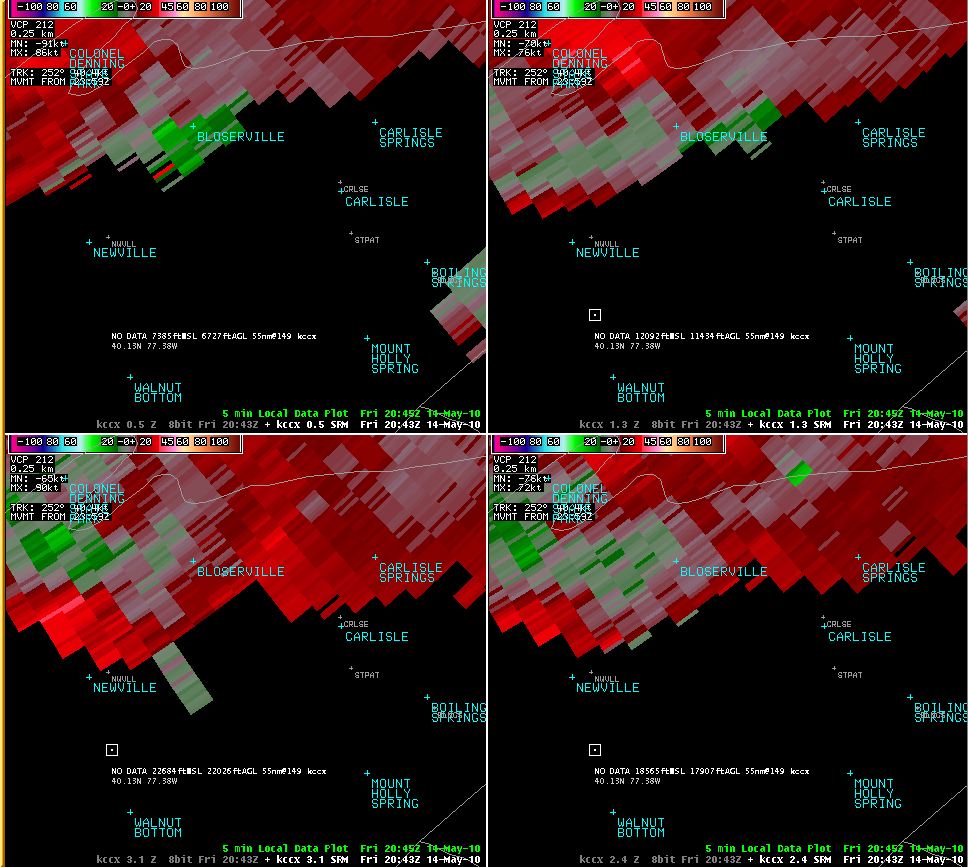 |
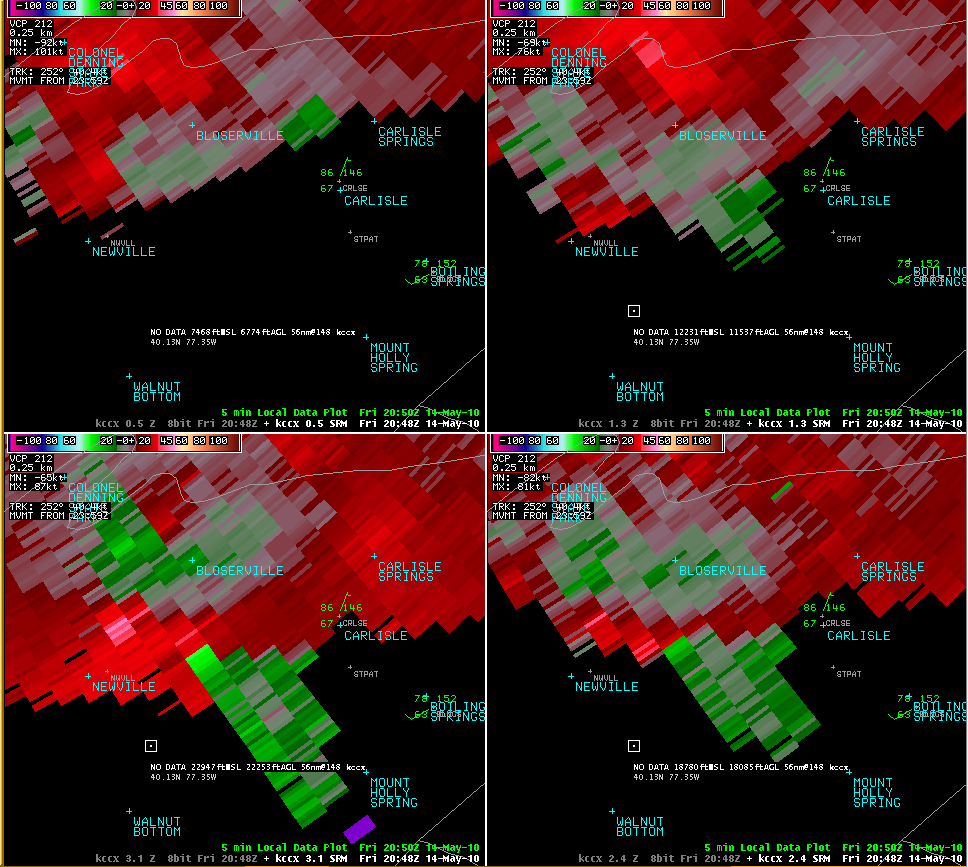 |
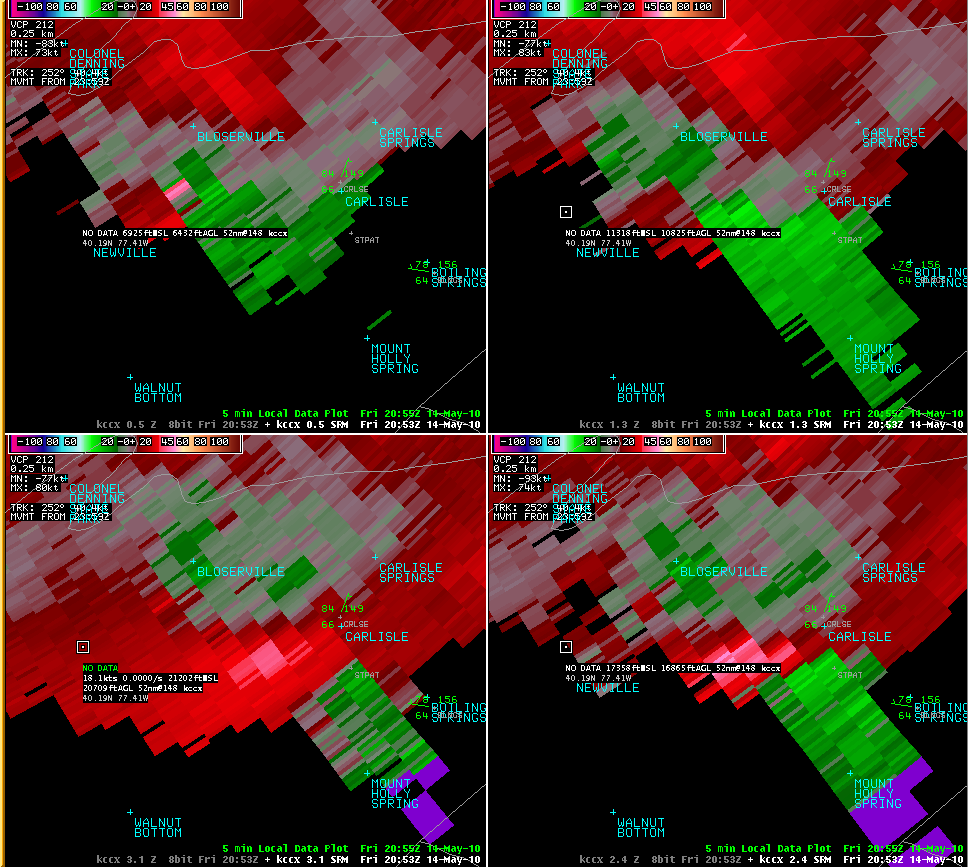 |
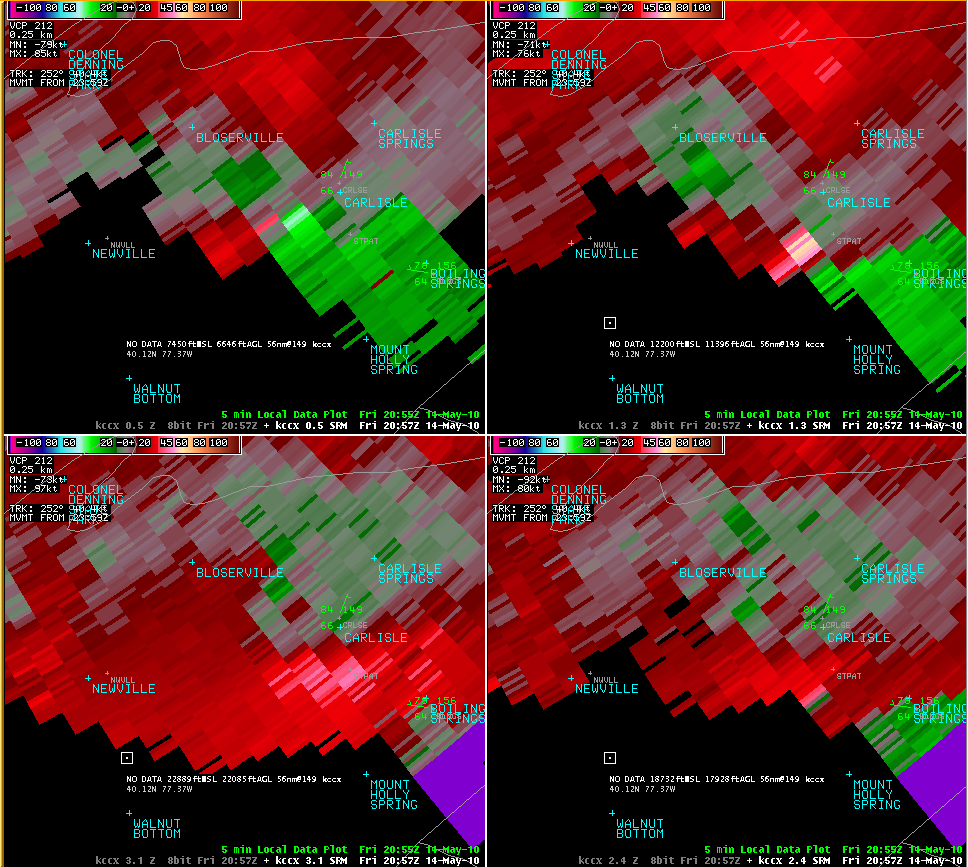 |
| Velocity 2043Z | Velocity 2048Z | Velocity 2053Z | Velocity 2057Z |
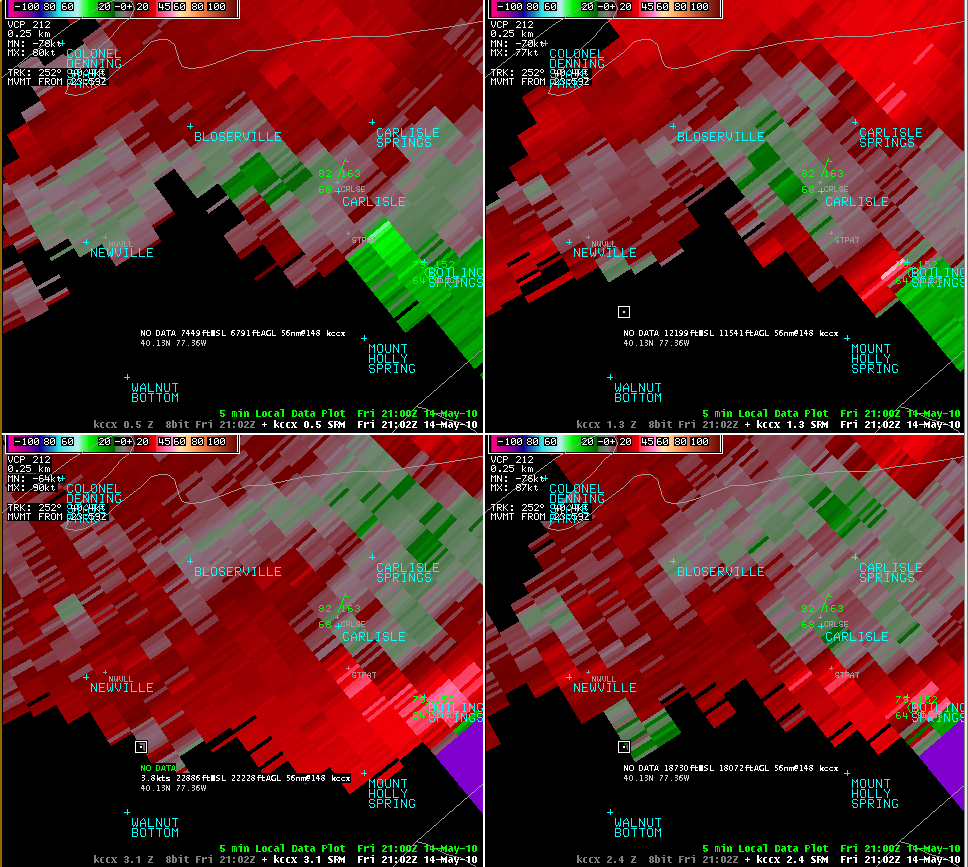 |
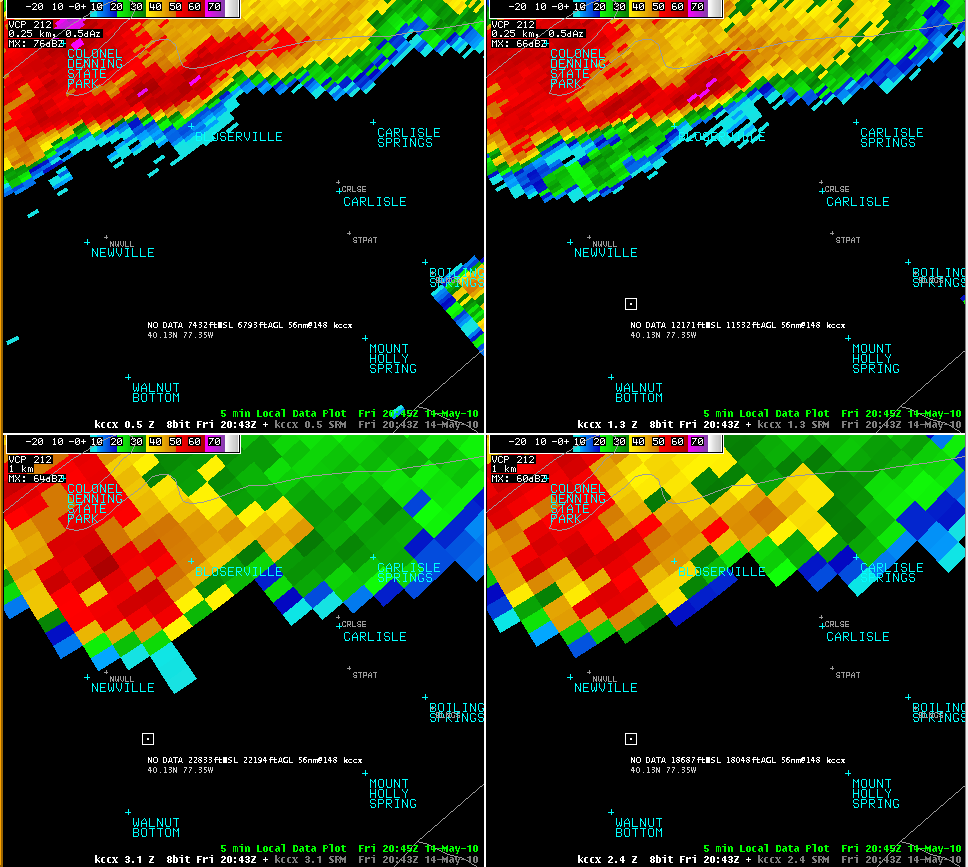 |
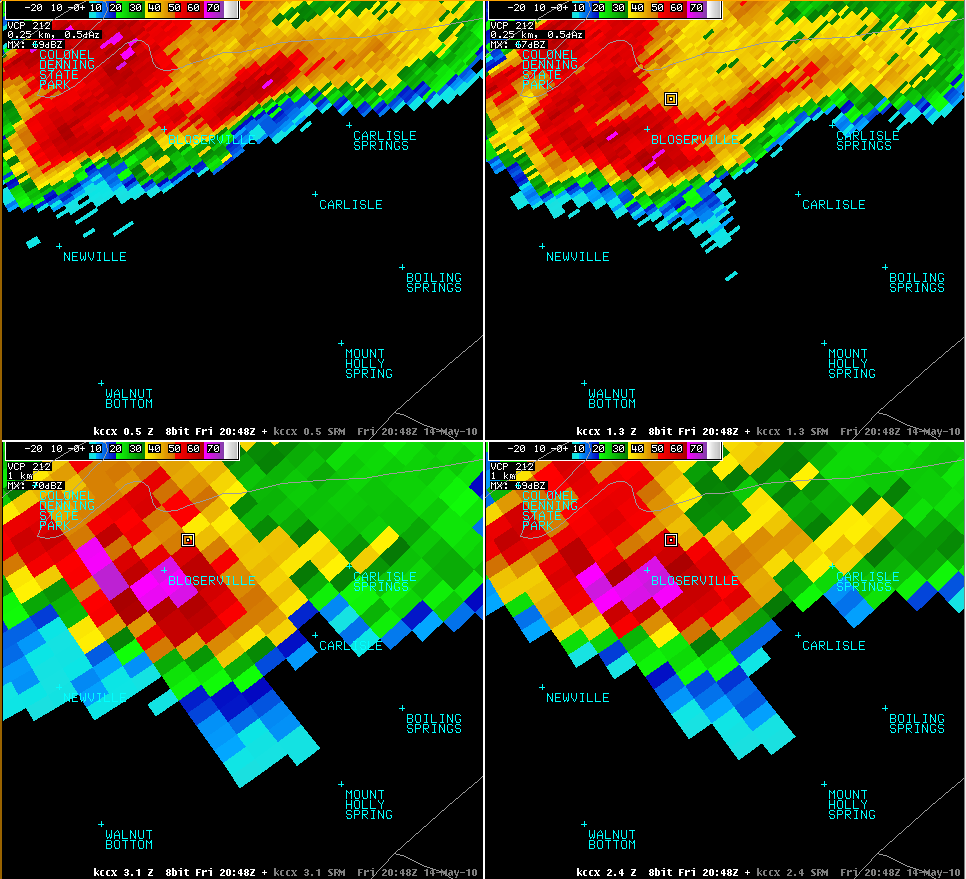 |
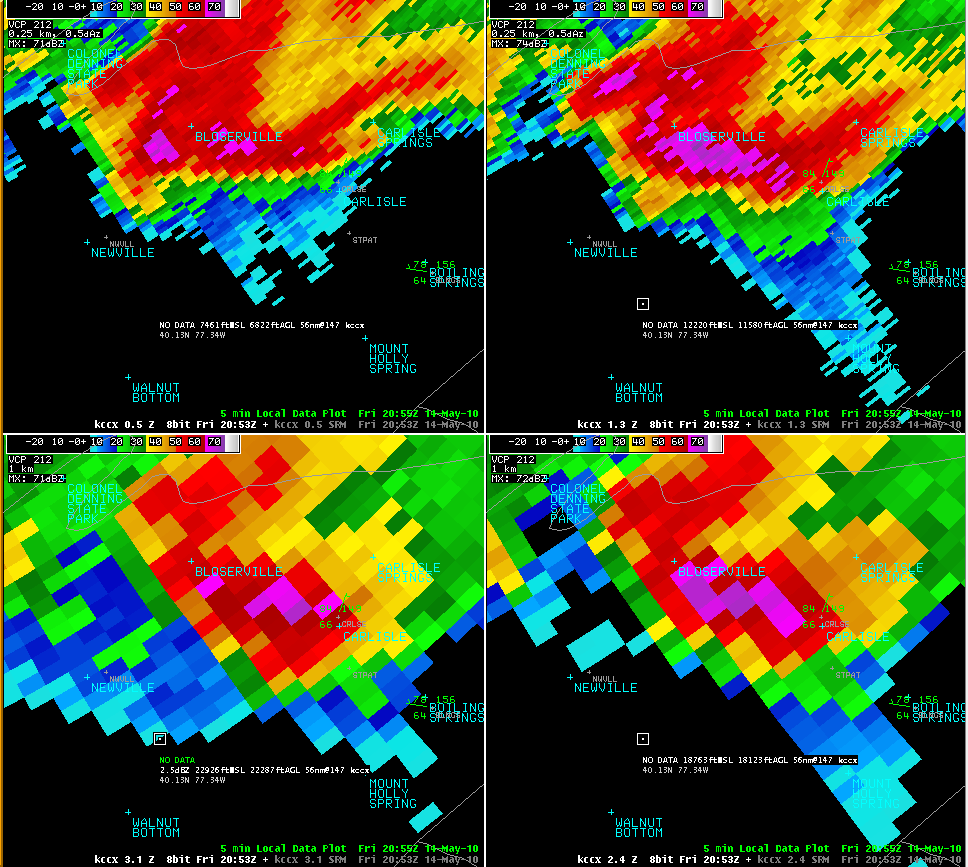 |
| Velocity 2102Z | Reflectivity 2043Z | Reflectivity 2048Z | Reflectivity 2053Z |
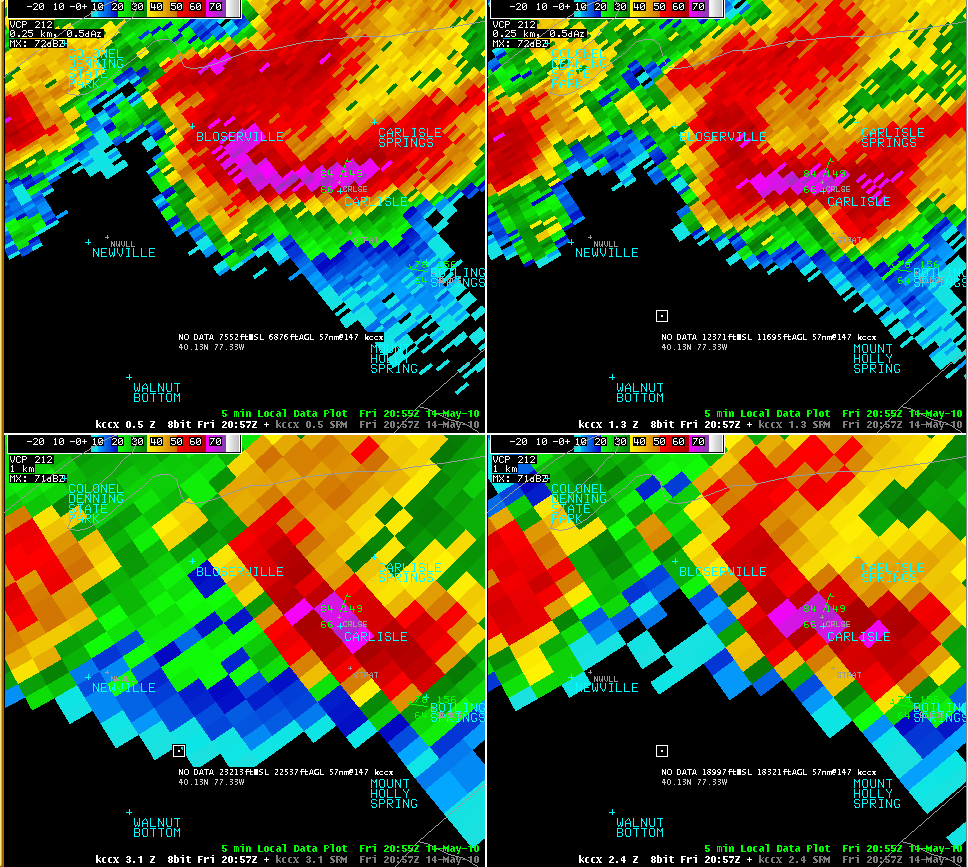 |
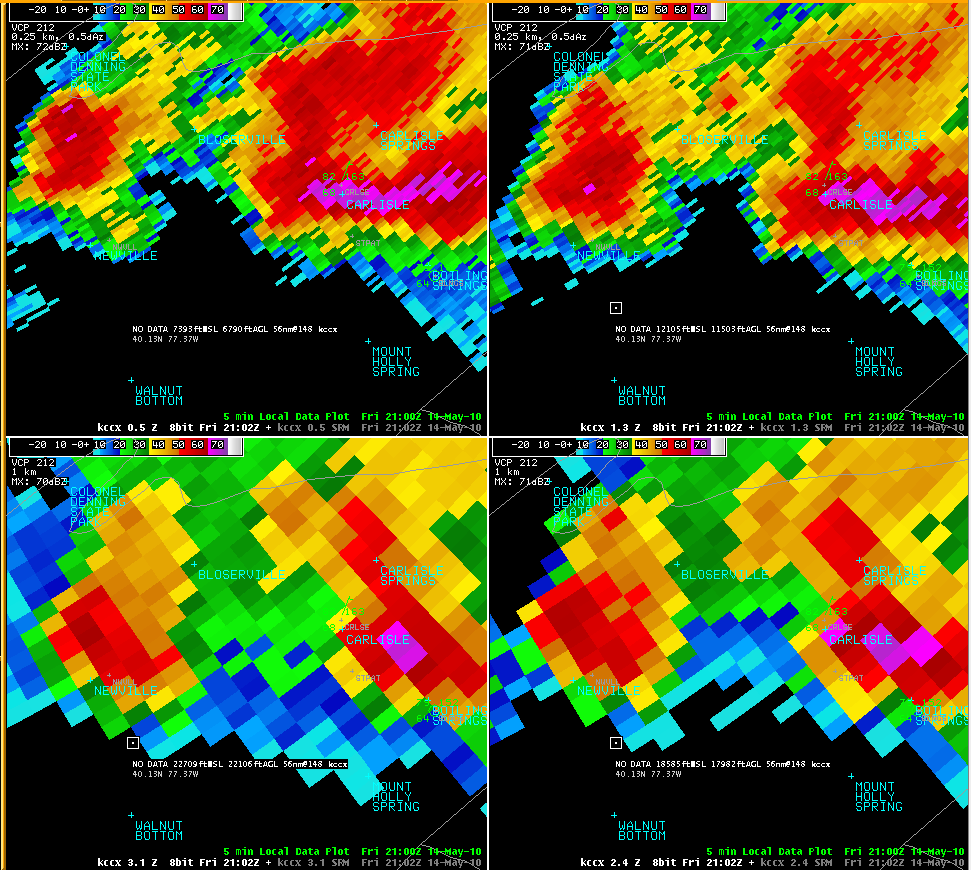 |
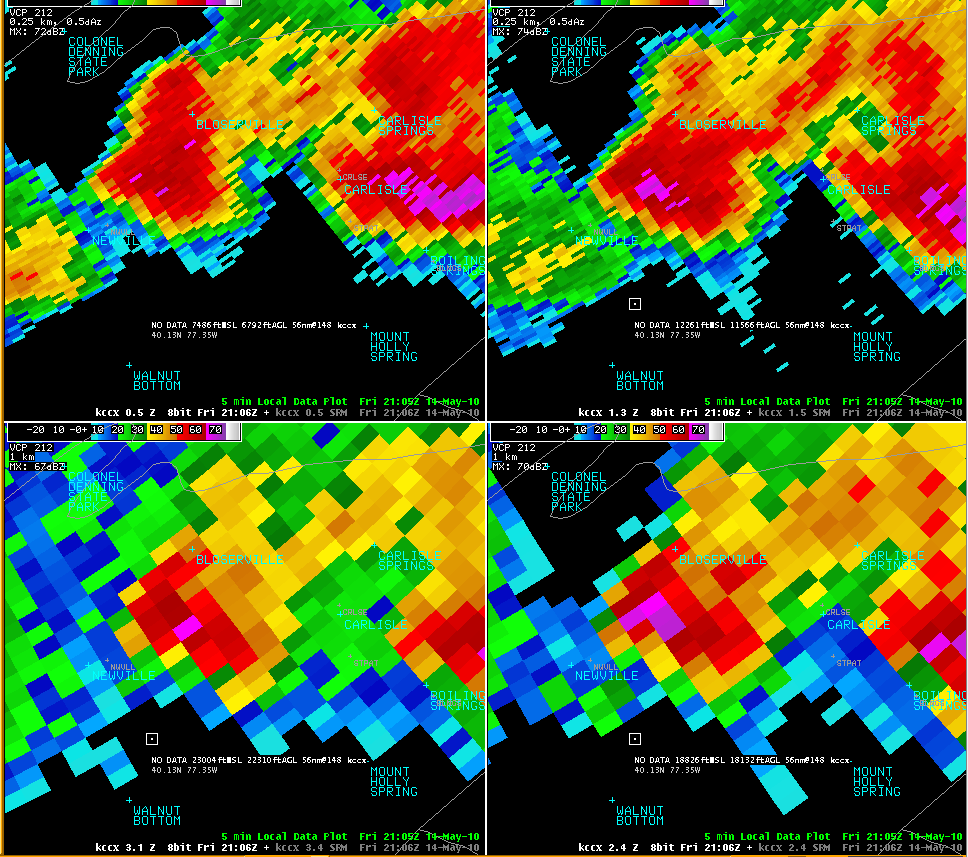 |
| Reflectivity 2057Z | Reflectivity 2102Z | Reflectivity 2106Z |
Storm Reports
..TIME... ...EVENT... ...CITY LOCATION... ...LAT.LON...
..DATE... ....MAG.... ..COUNTY LOCATION..ST.. ...SOURCE....
..REMARKS..
0320 PM TSTM WND DMG 5 SW ALTOONA 40.46N 78.47W
05/14/2010 BLAIR PA COUNTY OFFICIAL
911 CENTER REPORTED TREES DOWN AND POWER OUTAGES.
0345 PM HAIL GEISTOWN 40.29N 78.87W
05/14/2010 E1.75 INCH CAMBRIA PA TRAINED SPOTTER
0347 PM TSTM WND DMG JOHNSTOWN 40.33N 78.92W
05/14/2010 CAMBRIA PA NEWSPAPER
TREES...LARGE LIMBS AND WIRES DOWN.
0355 PM HAIL ROARING SPRING 40.33N 78.40W
05/14/2010 M0.75 INCH BLAIR PA TRAINED SPOTTER
0355 PM TSTM WND DMG 1 N MARTINSBURG 40.32N 78.32W
05/14/2010 BLAIR PA LAW ENFORCEMENT
ROOF OFF HOUSE ON PINEY CR RD
0405 PM TSTM WND GST 5 SW HUNTINGDON 40.45N 78.08W
05/14/2010 M85.00 MPH HUNTINGDON PA PUBLIC
WIND GUST RECORDED AT SEVEN POINTS VISITORS CENTER IN
HESSTON.
0440 PM HAIL 3 SW BOSWELL 40.13N 79.07W
05/14/2010 E0.75 INCH SOMERSET PA TRAINED SPOTTER
SPOTTER REPORTED PENNY SIZE HAIL COVERING GROUND.
0448 PM HAIL ELIZABETHVILLE 40.55N 76.82W
05/14/2010 M0.75 INCH DAUPHIN PA TRAINED SPOTTER
0455 PM HAIL CARLISLE 40.20N 77.20W
05/14/2010 E1.00 INCH CUMBERLAND PA PUBLIC
0456 PM HAIL CARLISLE 40.20N 77.20W
05/14/2010 E1.25 INCH CUMBERLAND PA PUBLIC
0503 PM HAIL CARLISLE 40.20N 77.20W
05/14/2010 E1.25 INCH CUMBERLAND PA PUBLIC
0504 PM HAIL CARLISLE 40.20N 77.20W
05/14/2010 E1.25 INCH CUMBERLAND PA PUBLIC
0509 PM HAIL CARLISLE 40.20N 77.20W
05/14/2010 E1.75 INCH CUMBERLAND PA PUBLIC
0510 PM TSTM WND DMG CARLISLE 40.20N 77.20W
05/14/2010 CUMBERLAND PA PUBLIC
TREES DOWN. POSSIBLE TORNADO - TRAIN-LIKE ROAR HEARD.
0510 PM HAIL MECHANICSBURG 40.21N 77.01W
05/14/2010 M1.75 INCH CUMBERLAND PA TRAINED SPOTTER
0519 PM HAIL MECHANICSBURG 40.21N 77.01W
05/14/2010 E1.75 INCH CUMBERLAND PA PUBLIC
0520 PM HAIL 7 WSW CARLISLE 40.16N 77.33W
05/14/2010 E2.00 INCH CUMBERLAND PA PUBLIC
MOST OF THE HAIL WAS GOLF BALL SIZE WITH A FEW IN EXCESS
OF 2 INCHES AT PLAINFIELD.
0540 PM HAIL 2 WSW YORK HAVEN 40.10N 76.75W
05/14/2010 M1.00 INCH YORK PA TRAINED SPOTTER
SPOTTER REPORTED QUARTER SIZE HAIL AT STRINESTOWN.
0545 PM HAIL 2 E MANCHESTER 40.06N 76.68W
05/14/2010 E2.00 INCH YORK PA PUBLIC
PUBLIC REPORT FROM MOUNT WOLF.
0545 PM TSTM WND DMG MANCHESTER 40.06N 76.72W
05/14/2010 YORK PA NWS EMPLOYEE
TREES AND WIRES DOWN 2 MILES WEST OF MOUNT WOLF.
0545 PM HAIL MANCHESTER 40.06N 76.72W
05/14/2010 E2.00 INCH YORK PA PUBLIC
REPORT FROM PEMA EMPLOYEE
0545 PM HAIL BAINBRIDGE 40.09N 76.67W
05/14/2010 M1.00 INCH LANCASTER PA TRAINED SPOTTER
0550 PM HAIL MARIETTA 40.06N 76.55W
05/14/2010 M1.25 INCH LANCASTER PA TRAINED SPOTTER
GROUND COVERED BY QUARTER SIZE HAIL.
0552 PM HAIL WRIGHTSVILLE 40.02N 76.53W
05/14/2010 M1.75 INCH YORK PA EMERGENCY MNGR
0555 PM HAIL WRIGHTSVILLE 40.02N 76.53W
05/14/2010 M1.00 INCH YORK PA TRAINED SPOTTER
0557 PM HAIL MARIETTA 40.06N 76.55W
05/14/2010 M1.50 INCH LANCASTER PA TRAINED SPOTTER
0600 PM HAIL COLUMBIA 40.03N 76.50W
05/14/2010 E0.88 INCH LANCASTER PA PUBLIC
0600 PM HAIL 5 N YORK 40.04N 76.73W
05/14/2010 M1.00 INCH YORK PA TRAINED SPOTTER
0600 PM TSTM WND GST 4 W CASHTOWN 39.88N 77.42W
05/14/2010 E60.00 MPH ADAMS PA TRAINED SPOTTER
PEA SIZE HAIL AND HEAVY RAINFALL.
0602 PM HAIL BAINBRIDGE 40.09N 76.67W
05/14/2010 M1.25 INCH LANCASTER PA TRAINED SPOTTER
0605 PM HAIL MOUNTVILLE 40.04N 76.43W
05/14/2010 M1.00 INCH LANCASTER PA TRAINED SPOTTER
0615 PM HAIL HALLAM 40.00N 76.60W
05/14/2010 M1.75 INCH YORK PA TRAINED SPOTTER
CAR WINDSHEILD SMASHED.
0615 PM HAIL 2 W LANCASTER 40.04N 76.34W
05/14/2010 M0.88 INCH LANCASTER PA TRAINED SPOTTER
0615 PM HAIL 2 NW ST. THOMAS 39.96N 77.77W
05/14/2010 M0.75 INCH FRANKLIN PA TRAINED SPOTTER
ESTIMATED 45 MPH WIND GUST.
0615 PM HAIL MILLERSVILLE 40.00N 76.35W
05/14/2010 M1.00 INCH LANCASTER PA TRAINED SPOTTER
0615 PM HAIL SPRY 39.91N 76.69W
05/14/2010 M0.88 INCH YORK PA TRAINED SPOTTER
0620 PM HAIL DALLASTOWN 39.90N 76.64W
05/14/2010 M1.00 INCH YORK PA TRAINED SPOTTER
QUARTER SIZE HAIL AT HIGH SCHOOL.
0620 PM HAIL 5 SE YORK 39.91N 76.67W
05/14/2010 M1.25 INCH YORK PA TRAINED SPOTTER
0622 PM HAIL WINDSOR 39.92N 76.58W
05/14/2010 E1.00 INCH YORK PA TRAINED SPOTTER
0630 PM HAIL HANOVER 39.81N 76.98W
05/14/2010 M0.88 INCH YORK PA TRAINED SPOTTER
0645 PM TSTM WND DMG WAKEFIELD 39.76N 76.17W
05/14/2010 LANCASTER PA EMERGENCY MNGR
TREES AND WIRES DOWN. WIDESPREAD DAMAGE BETWEEN
QUARRYVILLE AND WAKEFIELD.
0700 PM HAIL NEW FREEDOM 39.74N 76.70W
05/14/2010 M1.25 INCH YORK PA TRAINED SPOTTER
0742 PM HAIL TYRONE 40.68N 78.25W
05/14/2010 E1.25 INCH BLAIR PA PUBLIC
0815 PM TSTM WND DMG PINE GROVE MILLS 40.74N 77.87W
05/14/2010 CENTRE PA PUBLIC
TREE 4 FEET IN DIAMETER DOWN. SHINGLES AND SIDING ON
HOUSE DAMAGED. PEA SIZE HAIL. SEVERAL INCHES OF WATER ON
ROADS.
&&
 |
Media use of NWS Web News Stories is encouraged! Please acknowledge the NWS as the source of any news information accessed from this site. |
 |